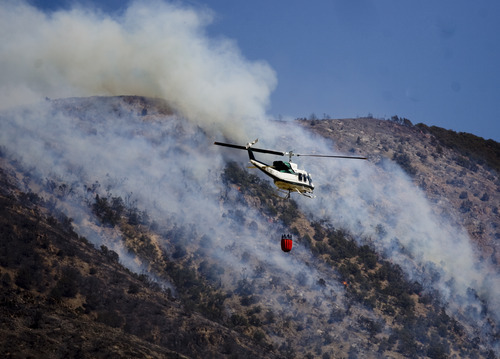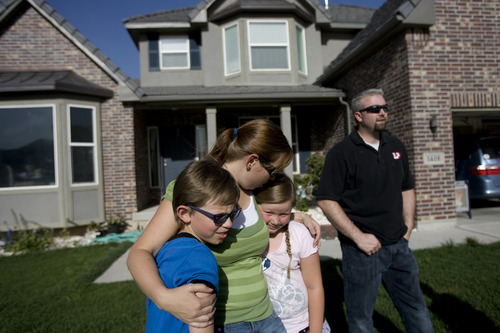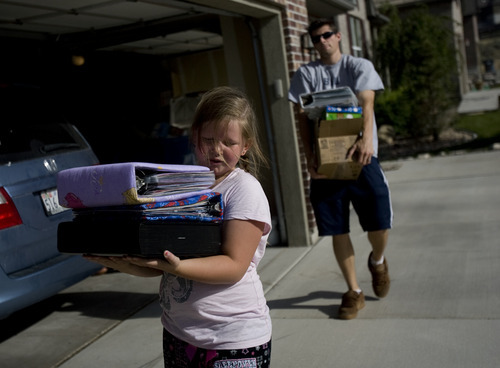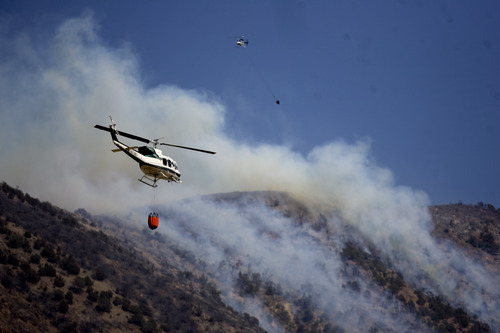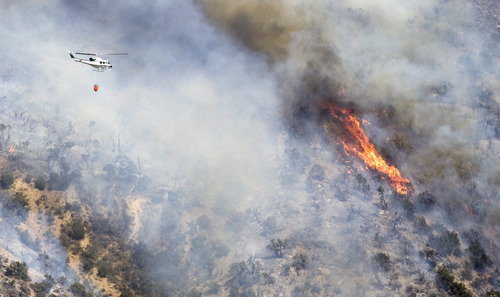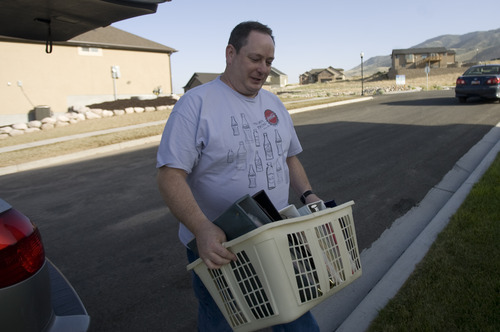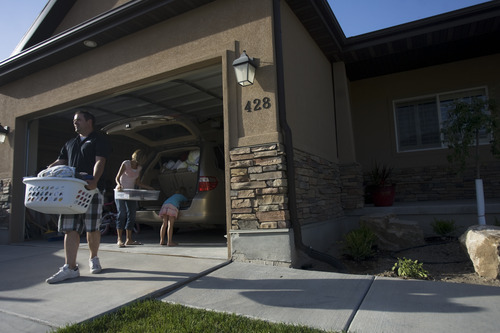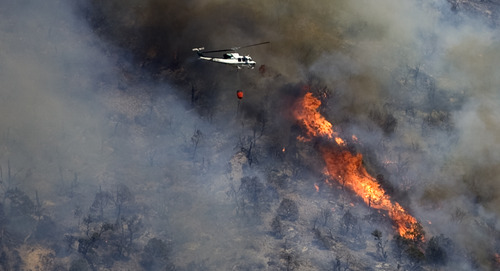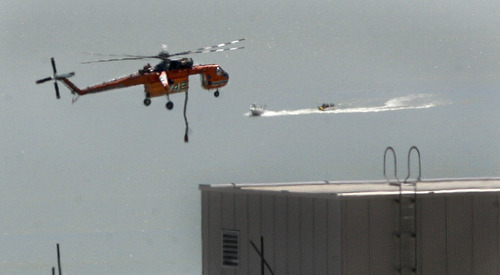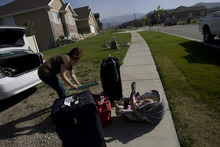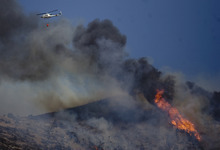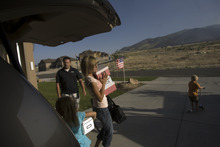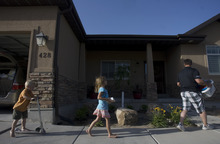This is an archived article that was published on sltrib.com in 2012, and information in the article may be outdated. It is provided only for personal research purposes and may not be reprinted.
Saratoga Springs • About 2,500 evacuees returned to Eagle Mountain and Saratoga Springs Saturday in a seemingly endless caravan of minivans stuffed with belongings after fire authorities lifted an evacuation order imposed a day earlier.
The 5 p.m. announcement that the evacuation order affecting 588 homes had been lifted triggered cheers and applause at the temporary shelter set up at Westlake High School.
Some evacuees left to return home immediately upon learning the order had lifted. Others stayed around to learn more about the fire.
"We feel comfortable letting people back in," Dan Osterkamp, Bureau of Land Management West Desert District spokesman, told the crowd. He added that "there is little to no chance of re-evacuation."
Authorities lifted the order even as crews continued to contend with relentless wind that initially slowed their efforts, but by Saturday evening had shifted south to aid their battle against the 6,023-acre wildfire in the foothills of the Lake Mountains west of Utah Lake.
Osterkamp credited the work of about 500 firefighters who made the Dump Fire — so named because the fire started by a landfill — the highest priority fire in the nation at the time due to its proximity to populated areas.
Sparked by two target shooters on Thursday afternoon, the fire burned within a half-mile or closer of some homes before an army of local, state and federal firefighters turned the blaze back into more remote grasslands and mountain ridges of juniper and pinyon late Friday. The firefighters were assisted by a fleet of water-bearing helicopters and air tankers bombing the flames with fire retardant.
By Saturday evening, crews had contained 40 percent of the fire, with full containment expected by Tuesday.
No homes or other structures had been burned, and no major injuries reported, though one firefighter suffered minor burns on Friday, but was back to work on Saturday, Interagency Fire Center spokesman Jason Curry said.
"We did have some growth in the fire during [Friday] night, but our forces were able to catch those [hot spots] right away," he said.
Jill Derington was among those grateful to be returning home.
She and her family had just half an hour to evacuate Friday, and she used the time to collect 40 handmade scrapbooks preserving memories of her husband and five children.
As Derington and her family walked out the door, her eyes welled up with tears as she realized what she was leaving behind.
"Just the thought of [leaving]," Derington said. "I have had children born in this house and to think it might not be here when I came back, it was really overwhelming."
Jami Hobbs, a resident in the Jacobs Ranch subdivision whose backyard was the fire line, said a fire authority told her to "expect it to be black up to your house when you get back."
As she tearfully prepared to leave with her husband and three children Friday, she gave each of them a suitcase and told them to fill it with their "most favorite things." She then packed up hard drives and bedding. She figured if any houses burned, hers would be first.
Hobbs said she was thrilled to see it wasn't as bad as they expected when they returned and started unloading their belongings.
"I was grateful it didn't get that far."
High winds, gusting past 50 mph, were expected to continue through the weekend, with a "red flag" extreme wildfire risk warning in effect for the entire state.
The Dump Fire was just one of a number of wind-whipped fires that also had fire crews taxed and forced some evacuations and road closures in Washington, Sanpete, Millard and Salt Lake counties.
Adding to the misery for firefighters were temperatures expected to hover near triple digits throughout Utah through Monday. Combined with continued low humidity — in places measured as low as 5 percent — and the state's parched rangelands and forests, fire watchers were bracing for what could be a long, hot and smoky summer.
In addition to keeping a close eye on the Dump Fire flames possibly shifting back toward populated areas, 400 firefighters on Saturday focused on keeping the fire from encroaching on four critical electricity transformers in Israel Canyon. If those go down, officials said, the whole region could lose power.
Earlier reports had the number of evacuees as high as 9,000 residents and 2,300 homes, but Curry said Saturday that was incorrect — a result of confusion. He said Saturday that no more than 2,500 people were evacuated from 588 homes, 394 of them in Saratoga Springs and 194 in Eagle Mountain.
Osterkamp said the discrepancy occurred because fire officials were initially using building permit records to calculate the evacuations. But many of those structures had yet to be built. The newer, lower numbers came from fire officials physically counting homes in affected neighborhoods.
The Dump Fire was the 20th this year blamed on target shooters. Overall, there have already been 400 wildfires in Utah; 380 of them human-caused.
Utah Gov. Gary Herbert called on Utahns to use more "common sense" in target shooting. He and other state officials urged target shooters to use established indoor and outdoor ranges instead of tinder-dry public lands. The governor also called on the state's municipalities to restrict fireworks during the upcoming Independence Day and Pioneer Day holiday weekends.
While about 300 people showed up by late Friday at the shelter established by the Red Cross at Westlake High, only 20 ended up staying the night, said Red Cross spokesman Scott Vest.
"A lot of people found family to stay with and made other arrangements for the night," he said.
Saratoga Hills subdivision evacuee Ashley Squire stayed with a friend Friday, but said she took advantage of resources at her disposal such as an air-conditioned shelter for her yellow lab Lilly. She also ate at Westlake.
"It was nice to come [to the shelter] because I didn't have to eat out every meal," Squire said.
Officials planned to keep the shelter open to house some of the firefighters Saturday night, Vest said.
Fire and fireworks restrictions
As the Fourth of July approaches, several cities along the Wasatch Front have issued fireworks restrictions. Fireworks are banned in the following areas:
Salt Lake City • All areas east of Foothill Drive, and east of 1300 East to 500 South, including the University of Utah campus
• All areas north of South Temple to State Street and North Temple to 200 West
• City Creek Canyon • East of 200 West/Wall Street to 300 West
• East of 300 West north of Wall Street through Beck Street to the city limit to the north
• All city parks and wildland urban interface areas
• All areas west of I-215
Unified Fire Authority • Foothill areas in Herriman, Draper, West Valley City, Holladay, Cottonwood Heights, Sandy and Draper
South Jordan • All city and county parks
• Within 200 feet of the natural vegetation border on the Bingham Creek open space and trial system (approx. 9400 to 10200 South, and 4600 to 4800 West)
• Within 200 feet of the western boundary of the natural vegetation border of the Jordan River Parkway open space and trial system extending to the city's eastern border (approx. 9400 to 11800 South and 300 to 700 West)
Provo • Within city limits, except in designated fire pits in improved campgrounds and recreation areas. The city also forbids target shooting in the city limits. Several wildfires this season were sparked by target shooters.
Smith's • The grocery chain announced that due to the high fire danger, it will not be selling aerial fireworks at its Utah stores.


